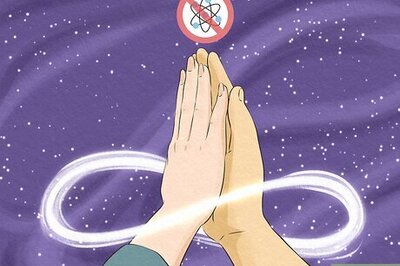
views
Even as the discomfort in Indo-Nepal relations, created by its new map continues, the KP Sharma Oli government is steadily opening newer fronts of friction. Now, the birthplaces of revered Gods have become the bone of contention.
Nepal recently objected to External Affairs Minister S Jaishankar’s statement that, “Who are the two greatest Indians that you can ever imagine? I would say, one is Gautam Buddha and one is Mahatma Gandhi.” He was speaking at the India@75 summit organized by CII.
The Nepal foreign ministry spokesperson in a statement said, “The matter remains beyond doubt and controversy and thus cannot be a subject of debate. The entire international community is aware of this.”
On Sunday, however, India tried to put a lid on the latest possible controversy regarding Gautam Buddha by issuing a clarification. The spokesperson for the Ministry of External Affairs, Anurag Srivastava, said the “EAM’s remarks yesterday at the CII event referred to our shared Buddhist heritage. There is no doubt that Gautam Buddha was born in Lumbini, which is in Nepal.”
On the other hand, the Ayodhya controversy is being kept alive by PM Oli. A day before raising objections to Jaishankar’s comment, Nepal media reported that Prime Minister Oli has instructed that the local government gather archaeological evidence of his claim regarding Ayodhya, Ram’s birthplace, being in Nepal. The archaeological department is already set to carry out excavation in Thori, Nepal.
This despite that fact that after an uproar over his comments that didn’t go down well either in India or Nepal, Kathmandu issue a clarification saying, “The remarks made by the Prime Minister are not linked to any political subject and have no intention at all to hurt the feeling and sentiment of anyone.”
But the statement also left room for furthering the idea when it added that there “have been several myths and references about Shri Ram and the places associated with him, the Prime Minister was simply highlighting the importance of further studies and research of the vast cultural geography the Ramayana represents to obtain facts about Shri Ram, Ramayana and the various places linked to this rich civilisation.”
Analysts believe that the move to appropriate cultural icons has a more political reason. Prime Minister Oli, while taking a very nationalistic stance, wants to end the “roti-beti” relationship with India. For instance, by indicating that Ram could have been Nepali, he is eroding the very premise of the age-old historical familial links between Nepal and India where marriages happened and still do between the two sides. Senior Nepali journalist Chandrakishore says,” Ram-Sita vivaah (marriage) is considered as part of people-to-people contact that dates back many centuries. The basis of this very relationship has been jolted by his claims.”
India and Nepal’s relations are built on “shared historical and cultural linkages and wide-ranging people to people contacts,” as is most often stated in India’s statements during visits and meetings between leaders of the two countries.
Gautam Buddha’s legacy also falls in the same category – shared historical and cultural linkages – with four of the three revered pilgrimage sites related to Gautam Buddha being in India - Bodh Gaya, Sarnath and Kushinagar. In fact, it is in Bodh Gaya, Bihar, where he attained Enlightenment and is one of the most holy places for any Buddhist.
Chandrakishore further explains that this unique relationship with India is because of the porous border between the two countries. Nepal doesn’t share this kind of bonhomie with any other country and Oli wants to end this with a regulated border. He says that this suggestion has been made in the EPG (Eminent Persons Group) Report of 2018 that is yet to be submitted to Prime Minister Modi.
There has been silence on part of India on the EPG report. The report has never been made public as it hasn’t yet been submitted. However, Nepalese media has been suggesting that India is not amenable to regulating the porous border and some other suggestions and so the report is gathering dust.
The EPG was formed in January 2016 and was tasked with reviewing the agreements and treaties, including the India Nepal Friendship Treaty, 1950. The report was finalised in 2018.
Article 7 of the India Nepal Friendship Treaty, 1950 says: “The Governments of India and Nepal agree to grant, on reciprocal basis, to the nationals of one country in the territories of the other the same privileges in the matter of residence, ownership of property, participation in trade and commerce, movement and other privileges of a similar nature.”
In fact, the 1950 Treaty that dissolved all others in the past also recognised the historical ties between India and Nepal as a basis for the Treaty. It begins by saying – “The Government of India and the Government of Nepal, recognising the ancient ties which have happily existed between the two countries; Desiring still further to strengthen and develop these ties and to perpetuate peace between the two countries”
Speaking on the recent developments with regards to Nepal, Professor SD Muni told News18.com that “India’s strategic community is convinced that Nepal would not go to this extent without the Chinese backing”. To consolidate his position in the party, which was clearly jeopardised, Oli has been projecting himself as one who can take on India so as to be able to get full China support. SD Muni added, “He is under Chinese influence, there is no question about that.”
The explanation gives a clear insight into the constant push by the Oli government to ruffle feathers in the India establishment but what explains India’s reluctance to reach out to Oli directly? Sources suggest that India is in a wait and watch mode and would not like to reach out at this stage to a man who has not only upset the equation but his own position in the party.

















Comments
0 comment